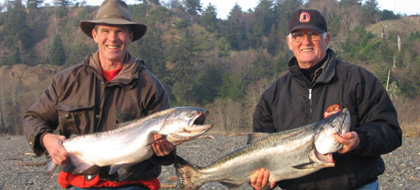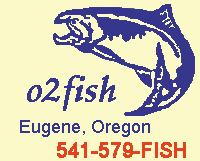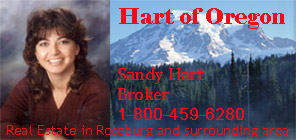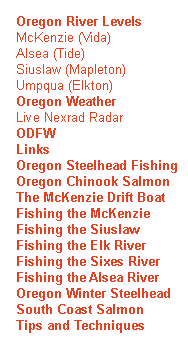


|
 |
|||||||||
 |
Gold
Coast Salmon
Coastal rivers north and south of Gold Beach producing big salmon
|
|||||||||
|
PORT ORFORD - It's an ill wind that blows no good, but the blustery winds basting the southern Oregon coast with rain on the eve of Thanksgiving couldn't be all bad. Just the forecast of gale-force winds had improved our odds: The Sixes River was merely busy with boats full of anglers in foul-weather gear. Had the weather been less-threatening, it would no doubt have been downright crowded, with twice as many boats jockeying for a spot to fish. Of course, the mid-week crowd may also have been thinned by the fact the river was running the color of a vanilla latte, due to the overnight runoff from upstream slides or logging operations. The locals could well afford to wait for better conditions, but we had come too far to go home without taking a shot at one of Oregon's premier fall chinook salmon rivers, gale-force winds or not. Besides, someone said, the wind doesn't blow down where the salmon live. So Patrick Roelle of Fishpatrick's Guide Service in Eugene eased his drift boat over the bank on a well-worn mud slide in the Sixes River canyon, a mile or so above the last official boat ramp on the river. His two passengers used a rope tied to his boat trailer to walk themselves backward down the steep bank. Soon, three chartreuse and silver Kwik-Fish, each with a bit of sardine fillet bound to its side with thread, were easing their way down the river beneath wind lines that swirled across the surface. The Sixes is one of a handful of small rivers scattered along Oregon's south coast between Cape Blanco and the California border that are home to late-arriving fall chinook salmon runs. Low summer flows allow sand bars to build up at the mouths of these rivers, and those sand bars often prevent fish from even entering tidewater until the river swells from heavy November rains. Some of those migrating sands still contain scattered flecks of the gold carried down to the ocean by the Rogue River, giving the town of Gold Beach its name. The chinook salmon runs on the Elk, Sixes and Chetco rivers (and on the Smith River just across the border in Northern California) may be the year's last, but they are first in the hearts of many West Coast salmon fishermen. For these rivers also produce some unusually large fish. Consider, for example, the experience of Brookings angler David Pitts in the few days before last week's big windstorm hit. Pitts, who is editor of an Internet fishing magazine (OregonAngler.com) caught four salmon on two different rivers. "The smallest one weighed 49 pounds, 4 ounces," Pitts said. His amazing stringer also included a 53-pounder from the Chetco River and a 52-pound, 4-ounce hen caught the previous day in the Smith River. Even more impressive was a Chetco salmon he helped another angler net. "It was a big girl, too," he said. "Sixty-three pounds, 7 ounces." Or about a half-pound shy of the 64-pound river record caught in 1998. "There's some real pigs in this river this year," Pitts said. "I've seen some monsters that have already spawned out" - including one that Pitts is convinced would have topped 64 pounds had it been caught while still bright. The chinook are so big, Pitts surmised, because the ocean off the southern Oregon coast is thick with food. And the late-run chinook get to spend a few more weeks gorging themselves at sea compared to their cousins on the Rogue, Umpqua, Siuslaw and most other coastal rivers. The Elk and Sixes don't produce salmon quite as big as the Chetco's, but the two Port Orford-area rivers hold salmon big enough to keep luring Roelle - and many other anglers - back between Thanksgiving and Christmas. "I started coming down with my dad, when growing up in Reedsport," Roelle said during a lull in the wind and rain. "And I've just always been drawn back to it, because of all the big fish. ... I mean, I caught a 48-pounder out of the Elk when I was 14 years old. I'm sure that made an impression on my mind. "We were fishing with (longtime Elk River guide) Denny Hannah, using a little Wee Wort (lure) just below the Elk River Hatchery," Roelle said. "It was 48 pounds and 48 inches long, and it took 48 minutes to get him in, is what we figured. "The crazy thing about it is that Denny Hannah hid the fish. He didn't want anybody to see it. He was totally secretive about it. He didn't want anybody to know we'd caught this 48-pound fish up here, and I was wanting to show it off. " By noon, the wind was getting really frisky. Sometimes it would blow upriver so hard that Roelle would turn the boat around so that the rain would pelt against our backs rather than our faces. Other times, the wind would sneak around a hill and push the boat downstream faster than good "plugging" technique suggested. A couple of times, the anglers in the front seats could hear their guide puffing like a steam locomotive pulling a load uphill as Roelle strained against the oars to keep the little boat from being blown sideways into the tree limbs reaching out from the banks. "That tree wasn't here yesterday," Roelle said, nodding toward a thick-trunked fir lying diagonally in the river, mud still oozing from the wound its root wad left in the side of the river bank. The other thing different from the previous days was the "bite." It seemed to have disappeared. A few of the anglers we encountered reported catching fish, but most were having as little luck as we were. Maybe all the surface commotion caused by the wind and the rain really did bother the salmon. "We just need to find a cluster of fish moving upriver," said Neil Peterman of Eugene, one of Roelle's regular clients. "The fish in these rivers tend to move in waves. The last time we were here was a perfect example of that. "We were anchored, and down around the bend two guys got hooked up and were hollering and carrying on and then another guy does and pretty soon everybody all along that stretch of river is catching fish and then, a half hour later, nothing ." Six hours into our trip, the tip of Peterman's rod finally began waving. Roelle beached the boat and grabbed his net. As soon as the salmon saw that, it made a run to the middle of the stream. Everyone held their breath when it came to the surface and did a series of cartwheels. But the lure held until Roelle scooped up the silvery buck, at which point it popped out of the fish's mouth and snared the top of the net. The catch, however, did not signal the arrival of another "wave" of fish. Just more waves of rain and wind. The Elk and Sixes are short rivers, as well as small. The most heavily fished section of the Elk is a nine-mile drift from the hatchery to Highway 101. The Sixes is open between the ocean and the confluence with its South Fork, but the heaviest boat pressure is between the ramps at Edson Creek Park and the Highway 101 Bridge. An even smaller stream that is beginning to draw angler interest is Pistol River, which runs into the ocean about 15 miles south of Gold Beach. Chinook fishing is allowed downstream of Deep Creek under a reduced bag limit of one salmon (adult or jack) per day, with a maximum of five per year. The Chetco is the largest of the south coast rivers, with late-fall chinook runs, running inland 50 miles and draining a good chunk of the Siskiyou National Forest. Most of the salmon fishing, however, is on the lower 10 miles, from the Ice Box Hole downstream. Three of the four "hogs" that David Pitts caught this month came from the six-mile stretch between Albert Loeb State Park and the Social Security Ramp. Hotel accommodations in Port Orford can be found here; Sea Crest 541-332-3040 Many Hotels available
in Bandon 25 miles north of Sixes. Mike Stahlberg Outdoor
Writer E-Mail: mstahlberg@guardnet.com
CALL
541-579-FISH (3474) |
||||||||||